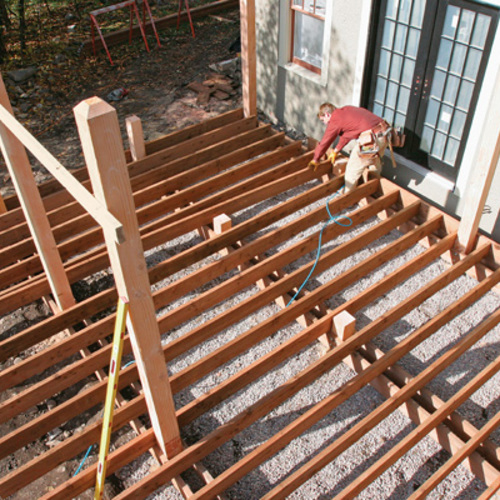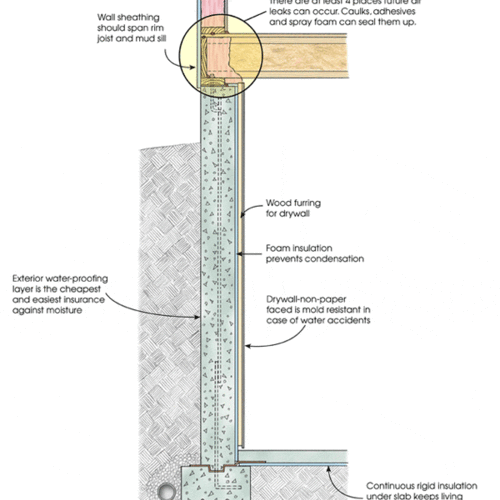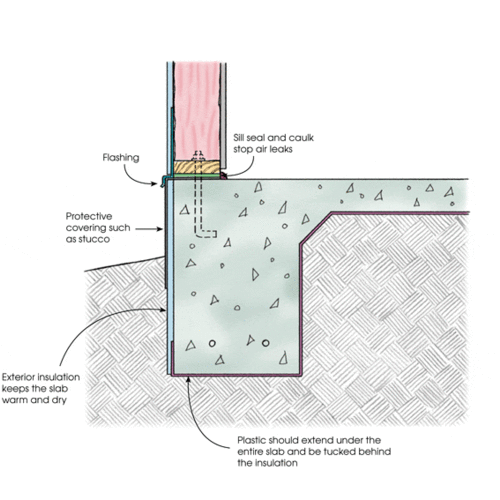ABOUT PIER FOUNDATIONS
Disturbing as little soil as possible
Pier foundations are unlike more conventional concrete footings and walls in that they support structural loads at a number of distinct points, not continuously. Pier foundations can be as simple as concrete-filled cardboard tubes dropped into hand-dug holes. But more complex foundations incorporating very deep piers or helical screws can support much greater loads.
To some green builders, one advantage of pier foundations is that they cause minimal disruption to the soil environment. Excavation can be performed with a shovel, and existing roots and soil organisms remain mostly undisturbed. At the end of the building’s useful life, the site will be easier to restore to a natural state than a site with a full basement.
Design starts in the soil
The number and size of the piers depends on how much weight the underlying soil can hold. The standard design load in the International Residential Code assumes a 40-pound live load; dead load is commonly calculated at between 10 and 15 pounds per square foot, depending on the materials used for construction.
Hard-packed gravel may be able to handle as much as 3,000 psf while soil with high clay content or lots of organic material will support much less weight. Recommendations of the IRC are summarized in a table (referenced in the code as 401.4.1). In situations where the bearing capacity of the soil is questionable, it may be necessary to call in a soils engineer for help.

This article is only available to GBA Prime Members
Sign up for a free trial and get instant access to this article as well as GBA’s complete library of premium articles and construction details.
Start Free TrialAlready a member? Log in










6 Comments
house foundation
I am building a home & thinking of using peir & beam . A ny suggestions on using cardboard tubes for concrete forms ? I plan on using concrete from a batch plant to get a quality mix . My only concern is how far apart to put the peirs &what diameter to use . My plans are about 1800 sq.ft. one story 3 bed room house w/a low pitch normal roof plan
Foundation engineering
Anonymous,
If you live in an area subject to building codes, you clearly need to consult with an engineer. The answer to your question depends on local soil conditions, frost depth, and the characteristics of your house.
If you live in a rural area that is not subject to building codes, you need to purchase and study a collection of basic construction manuals before you begin building. Even a simple, classic book like the 1969 volume, "Low-Cost Wood Homes for Rural America: Construction Manual" (U.S. Department of Agriculture) will get you started.
In other words, if you aren't sure about how to build a foundation, you're tackling a job that may be over your head — at least until you do some more studying.
piers
I may need to install a few piers for a third floor addition on a house , i have one pressure point from roof load that my require under pinning of the foundation. Is there any compony that can instal piers inside of house crawl space. Truss company says there is a load of maybe 25000 lbs at one spot. Can one pier support that much wieght or does it take many ? job is in eastern ontario canada
Concrete piers in a crawl space
Anonymous,
It's impossible to answer your question without a site visit.
You need to consult an engineer and an experienced contractor.
varmints
The idea of building on piers is appealing, but I'm concerned about varmints moving in under the house. How can I avoid the varmints without installing that godawful wood slat skirt material? Or will wide open space (1~3 ft) under the house be fine?
Ethan
You are more likely to attract vermin with a skirt than an open space. Building a skirt really just creates a poorly designed crawlspace, with features you wouldn't otherwise include. And if you build it at the same time as the house the code sees it as a crawlspace, bringing with that the full range of requirements.
If you leave enough height for construction and maintenance access and keep the ground clear, the area under the house will be pretty inhospitable to vermin.
The chief drawbacks with pier foundations are:
- Bringing services in, especially in colder climates.
- Providing lateral support, which precludes them from many seismic zones.
- Having to insulate the floor, rather than the walls as you do with a traditional foundation.
Log in or become a member to post a comment.
Sign up Log in